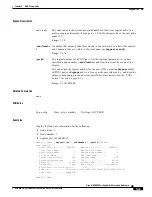
5-63
Cisco MGX 8850 Routing Switch Command Reference
Release 2.0, Part Number 78-10467-04 Rev C0, October 2001
Chapter 5
PNNI Commands
dsppnni-idb
Syntax Description
Related Commands
none
Attributes
Examples
Display the link-state information for the following:
•
Node index: 1
•
Node number: 1
•
Logical port ID: 16848901
Geneva.7.PXM.a > dsppnni-idb 1 -nodeNumber 1 -portId 16848901
node index:1
Local port id....... 16848901 Remote port id....... 16848901
Local link index.... 1 Remote link index.... 1
Local node number... 1 Remote node number... 2
PGL node index...... 0 LGN node index....... 0
Transit restricted.. off Complex node......... off
Branching restricted on PGL.................. false
Ancestor............ false Border node.......... false
VP capable.......... true Link type............horizontal
Non-transit for PGL election.. off
node id...............56:160:47.00918100000000107be92f46.00107be92f46.01
node name.............pswmgx2-2
Geneva.7.PXM.a >
node-index
The node index is the system-generated number of the local logical node. In a
multi-peer group hierarchy, the range is 1–10. In the current release, the only node
index is 1.
Range: 1–10
-nodeNumbe
r
A number that uniquely identifies a node in the network. For a list of the remote
node numbers that are visible to the local node, use dsppnni-node-list.
Range: 1–256
-portId
The logical number for a PNNI port. Use this optional parameter if you have
specified a node number (-nodeNumber) and want to narrow the scope of the
display.
You can obtain the logical number for the port ID by executing dsppnports for
all PNNI ports or dsppnport a:b.c.d for a specific port (where a,b,c, and d are the
values corresponding to the physical portID. For more details, see the
“PNNI
Format” section on page 5-5
.)
Range: 1–2147483648
Log: nolog
State: active, standby
Privilege: ANYUSER
















































